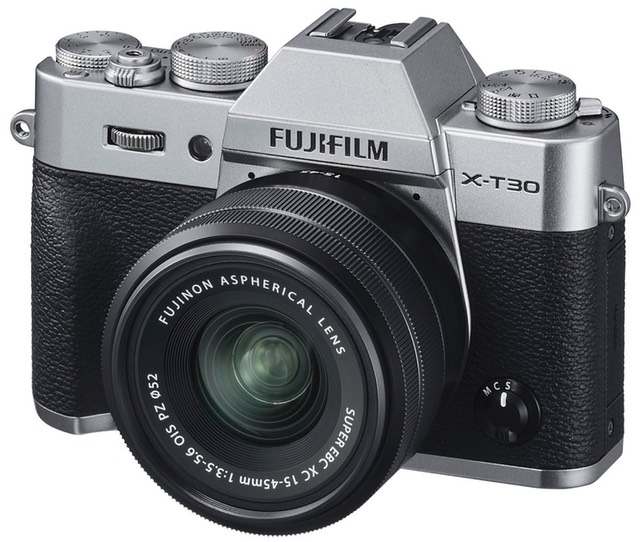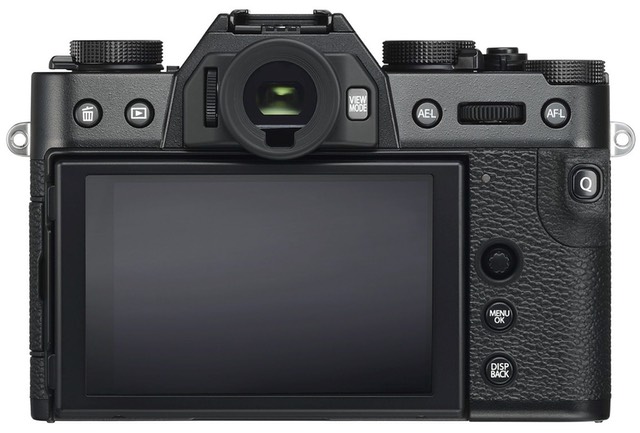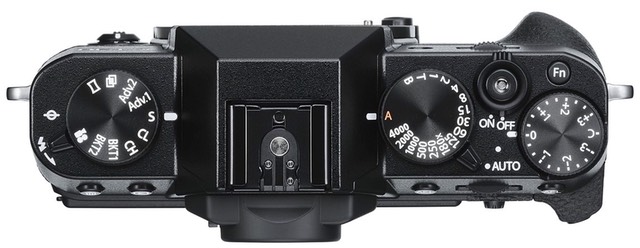
What is It?
The X-T30 shares a lot of the specification of the X-T3, but in a smaller, lighter, somewhat less robust body. The underlying chassis is still metal, but there's less weather-sealing and fewer and smaller controls on the X-T30 than on its bigger brother, the X-T3. Coupled with the smaller size, the body ends up weighing less, too.
The X-T30 features the same current Fujifilm state-of-the-art 26mp APS-C sensor, X-Processor 4, phase detect autofocus system, as well as other internal features of its bigger X-T3 brother, but has fewer direct controls as well as some modest performance compromises in a few key spots.
That said, the X-T30 is well endowed with features and performance.
At the heart is the X-Trans sensor, which isn’t stabilized. That sensor is a state of the art Sony BSI Exmor, the same as used in the X-T3, and Fujifilm’s best sensor for APS-C to date. Backing up the sensor is the X-Processor 4, which allows the camera to shoot at high frame rates (20 fps at full APS-C crop, 30 fps with a further 1.25x crop, both in electronic shutter mode in a short burst), and which does all of Fujifilm’s current JPEG color rendering.
Autofocus is mostly the same between the two cameras, too, as the X-T30 uses the same 425 phase-detect zones that cover pretty much the entire frame. The focus system has been extended in performance capability from earlier cameras (X-T2, X-T20) with numerous features, including what Fujifilm calls non-stop phase detection, face and eye detection, and more.
Since the sensor is integral to the video, it isn’t surprising that the video capabilities of the X-T30 are pretty much the same as the X-T3: 4K/30P in either DCI or UHD frame size (the X-T3 adds 60P), recorded at 200Mbps. Like the T-3, the T-30 can record 1080P up to 120 frames per second, though this comes with a 1.3x crop. The T-30 also doesn’t cripple the HDMI output: you get 10-bit 4:2:2 to external recorders, and F-Log is supported.
The X-Processor 4 provides the full set of Fujifilm “looks,” including the most recent Externa film simulation, which first appeared on the X-H1.
While the sensor-related aspects are nearly identical between the X-T3 and X-T30, it’s when you get to other features that you start to see the simplification in the lower-cost model. The X-T30 uses a lower-specified shutter that only gets to 1/180 flash sync and maxes out at 1/4000 and 8 fps. The EVF is the older 2.36m dot one with a lower magnification, and, of course, all this comes in a smaller, lighter body with a few controls missing.
That EVF normally runs at 60 fps, but there is a 100 fps mode that provides faster refresh when shooting action. Surprisingly, the Sports Finder mode is implemented on the X-T30. That’s where the camera applies a 1.25x crop to what it saves, but shows the full frame along with a crop line indicating where the actual image will be created.
There’s no ISO dial on the X-T30, though it does have a separate Drive Mode dial (that’s tucked underneath the Shutter Speed dial on the X-T3). The X-T30 has no Direction pad buttons on the back, one fewer programmable buttons, and no PC sync socket in also obvious feature removals compared to the X-T3. The X-T30 has a minor bulge on the front for gripping, while the X-T3 has a somewhat deeper and more substantive bump grip (though still not a complete hand grip like the DSLRs).

Less obvious, the rear LCD on the X-T30 only tilts up and down, while the X-T3 has an LCD that enables two-axis tilting. Also less obvious is that the X-T30 has more minimal weather sealing, while the X-T3 is well sealed.
One thing the X-T30 has that the X-T3 doesn’t is a pop-up flash. With a GN of 20 (feet; 6m), it’s not particularly powerful, but it does work well for close fill work. The flash pops up via lever on the top left plate of the camera, and has one and only one position (some pop-up flashes can be tilted back to provide bounce flash). Note that the flash sync speed is only 1/180, though.
There's not a ton of customization available (four buttons, one of which is a rear command dial press), but what can be customized does have a deep list of what can be assigned. The Q button allows quick access to many of the things you'd want to set while shooting. Finally, Fujifilm also supports the MyMenu concept pioneered by Nikon, meaning you can put other oft-used items there to access them quickly.
In terms of connectivity, we have USB-C, micro-HDMI, and 2.5mm mic input ports, as well as Wi-Fi and Bluetooth. Fujifilm's smartphone app is a bit better than most of the camera makers. It fairly seamlessly pairs to the camera, and can even update the camera's firmware when updates appear (very nice touch). As with most of the smartphone connectivity we've seen, most of the heavy lifting is done at the phone end, though.
Like many lower-priced cameras we only get a single SD (UHS 1) card slot, and that's in the battery compartment. Not my favorite placement, but it eradicates a door mechanism and extra sealing, a common simplification in lower cost cameras. The battery is Fujifilm’s usual NP-W126S, while CIPA says gets 380 shots per charge. The battery can be charged in camera via the USB port.
In terms of basic specifications, you can see that there's not a lot of differential between the SLR-like models at one level. It's only in the details that you start to see the big differences between these four models:
| X-T100 | X-T30 | X-T3 | X-H1 |
|
|---|---|---|---|---|
| sensor | 24mp Bayer | 26mp X-Trans | 26mp X-Trans | 24mp X-Trans |
| ISO | 100-51200 | 80-51200 | 80-51200 | 100-51200 |
| Focus | 91 pt Phase Detect | 425 pt Phase Detect | 425 pt Phase Detect | 325 pt Phase Detect |
| Rear LCD | 3" 1m dot tilting |
3" 1m dot tilting | 3" 1m dot dual tilting | 3" 1m dual tilting |
| EVF | 2.4m dot | 2.4m dot | 3.7m dot | 3.7m dot |
| Shutter | 30 sec - 1/4000 M 30 sec - 1/32000 E |
30 sec - 1/4000 M 30 sec - 1/32000 E |
30 sec - 1/8000 M 30 sec - 1/32000 E |
30 sec - 1/8000 M 30 sec - 1/32000 E |
| Flash | Built-in GN 5m | Built-in GN 5m | included external | included external |
| Flash Sync | 1/180 | 1/250 | 1/250 | |
| Video | 4K/15P 1080P/60/50/30/25/24 |
4K/30P/25P/24P 1080P/120/60/50/30/25/24 |
4K/30P/25P/24P 1080P/120/60/50/30/25/24 |
4K/30P/25P/24P 1080P/60/50/30/25/24 |
| Other | USB 2 | USB 3.1 gen 1 | USB 3.1 gen 1 | USB 3.0 |
| Weight | 448g | 383g | 593g | 673g |
| Card(s) | Single UHS-I | Single UHS-I | Dual UHS-II | Dual UHS-II |
| Body Price |
US$500 | US$900 | US$1500 | US$1200 |
The X-T30 is available in all-black or two different panda (chrome on black) body styles, is made in China, and sells for US$900 body only, or US$1000-1300 with various lens kits.
Source of the reviewed camera: B&H loaner
Fujifilm’s page for the X-T30.
How’s it Handle?
Okay, let’s get this one out of the way first: the X-T30 didn’t pass the “mom” test. Now before you go dismissing that, we’re talking about someone who had one of the original Nikomat cameras and has four master degrees, including one in computer science from Carnegie Mellon.
What stopped my mom? The on/off switch.

While Fujifilm uses the Nikon-standard around-the-shutter-release switch, the small top plate coupled with a cheaped-out design decision had my mom looking at the top of the camera and not figuring out which lever did what. The big problem? She associated the big white exposure compensation marker as having something to do with on/off (it essentially points to Off).
The reason for this is really simple: Fujifilm didn’t paint the rigged plastic indicator on the back of the switch that surrounds the shutter release. Thus, in the black body version I tested, the white On and Off markers on the top plate don’t align to anything else white visually. Had they painted that ridge white, my mom probably would have gotten it.
Indeed, the bigger X cameras have enough room on the top plate and match a clear marker on the switch to the On/Off positions visually. Even on the panda style bodies (chrome over black), Fujifilm paints the positions and the markers all black.
It may seem silly that I’m pointing this small detail out, but my mom’s onto something here. Virtually all of the handling issues I have with the X-T30 revolve around cheaping out.
The most noticeable of these is that there isn’t a Direction pad (or in the Fujifilm world, a circular array of buttons that work as a Direction pad). We do get a thumb stick, though this is a very cheap part I worry about. It’s easily moved but doesn’t feel 100% secure in the direction of movement on my sample. I have a difficult time getting it to move reliably diagonally, for instance.
Meanwhile, the X-T30 has the Sony problem: all the buttons are very small, difficult to find by feel alone, and not at all glove friendly. At least Fujifilm put the command dial between the two buttons I’d likely want to find and use by touch (AEL, and AF-L), meaning that over time I just have to remember which is to the left and which to the right of the dial.
The dials, too, are on the cheap side. None are locking, and some are not quite as secure in holding position as the higher end Fujifilm cameras are. Fujifilm has obviously not studied with an Italian designer as Nikon has: the front and rear command dials are simply bolted in perpendicular to the body. (Take a closer look at many higher-end Nikon designs and you’ll see subtle tilts and rotations in their placement that feel more natural under the fingers.)
Which brings me to the grip. Here’s how things go in the Fujifilm world:
- X-T100? Soap bar, no grip.
- X-T30? Soap bar, small ridged areas on front and back.
- X-T3? A more pronounced front hand positioned sculpted on a big soap bar.
- X-H1? You guessed it: a full, deep, DSLR-like hand grip.
All of the Fujifilm's have the faux leather gripping surface on their primary body areas, which makes the soap bar designs less slippery than soap, but still, gripping flattish texture is not the same as holding a grip.
The result of these lesser methods on the X-T30 mean that if you’re using some of your fingers to fully grip the camera, your other fingers are not exactly falling naturally on many of the controls. As you start to reach for a control, you tend to have to two-hand the camera so as to keep it fully steady. If you try to cheat by moving your thumb further up the back of the camera, there’s a strong tendency for those with smaller hands to accidentally press the poorly-placed Q button (quick menu). I can't tell you how many times I've managed to accidentally trigger the Q button on the X-T30. It's one of the most frustrating aspects of the handling.
Thing is, I kind of like the other controls Fujifilm chose to put on the X-T30. Do I need a Direction pad? No. I just need a more reliable thumb stick, and it probably needs to be a bit further up the back than it is. Hand position seems a bit awkward on the X-T30 no matter how small or large your hand is, but particularly for long-fingered or large-handed folk. The Q button is also in a bad place (it's in a better place on the X-T3, though still not optimal).
Fujifilm made some good handling choices I should point out: the exposure compensation dial takes real force to move; it doesn’t easily dislodge from the set position, as it does with some cameras. The separate focus switch and drive mode dial are rarities on cameras at this price level, and much appreciated.
Another thing that works well is using your thumb on the LCD to control the position of the autofocus sensor being used. There’s little lag and it works better and faster than some other implementations I’ve seen. The only problem is that you don't have much room between your face and the LCD to get that thumb into. So this, too, feels a bit awkward.
Small cameras are tough to get the ergonomics and haptics correct for (as are very large cameras). Hand sizes vary considerably among users, so there’s no “perfect” position for everything. That said, I get the feeling that Fujifilm didn’t really go very deep in testing their assumptions here. A handful of very small and not very expensive design choice differences would have gone a very long way toward making the X-T30 a highly desirable camera for its handling. Instead, it's just decent.
As it sits, it’s a camera I had to adapt to more than it adapting to me. Moreover, I’d have issues with using it in the cold or any time the body might get slippery (e.g. mist). That said, there are enough nice touches that I can’t be too tough on my handling assessment lest I give you a wrong impression. The X-T30 seems like a competent design with rough edges, rather than a flawed design. There is a difference between those two, and when you’re making so many control choices while shooting, that difference can be important.
To state it again: the X-T30 has some rough edges, but nothing that will stop you shooting or interfere in ways that catch you up (short of shooting in winter with thick gloves).
How's it Perform?
Battery: I got less than the expected number of frames in my testing, though I'll point out that I used the 15-45mm zoom most of the time, and it's a powered lens with a whining OIS circuit. Driving that lens clearly was sucking power, so if you go the same route—too create a truly small camera/lens combo that's versatile—make sure you carry an extra battery or two. On average, I was getting somewhere around 300 frames a charge.
Focus: For most uses, I have no real issues here. In well lit and contrasty situations with non-moving or slow-moving subjects, the system is fast and precise. AF-S (single servo focus) users should have virtually no issue with the camera, particularly if they stick to the central section covered by phase detect sensors.
Tracking focus is a bit different.
We have the usual Eye Detection ability in the more automatic focus modes, and it works very well. As I noted with the X-T3, though, when the camera or subject is moving fast, there can be a slight moment where the eye is lost and the camera drops back to Face Detection while it re-looks for the eye. Eye Detection can be "auto" or you can pick left or right eye (but not closer eye). Like most Eye Detection systems, there can be a tendency to focus on the eyebrows/eyelashes, though Fujifilm is the only system I know of that actually tries to detect using the eye itself; you can see that at work at times when the small detection box goes horizontal instead of a small rectangle.
Where I'm not sure Fujifilm has caught state-of-the-art with autofocus is in tracking erratic, fast motion using AF-C (continuous servo focus). Because most of my sports coverage is shut down in the summer months as I was testing these cameras, I wasn't able to do all the testing I would have liked, but in some mountain biker testing I could see the system struggle to keep the subject in tight focus.
Let me try to describe that more carefully. On my D5, a sequence that achieves focus pretty much stays locked on the thing that was originally focused. If you look at the eyes of a soccer player, for instance, every frame has the same focus plane (and if I used the AF system right, that's the player's eyes). On the Sony systems, one of the things I don't like is that there is some "drift" of the focus plane, even on the A9, which is the best of the bunch. The focus plane doesn't move much, but in that same soccer player scenario it'll drift forward and back of the actual eye by a millimeter or two from frame to frame.
The X-T30 (and X-T3) sort of match the Sony performance if the subject is well centered and coming directly at you at a constant speed: a bit of fore/aft drift, but very acceptable focus. But if the subject is moving more erratically (across the frame), and particularly if it gets out of the central area, I see clear focus "misses." Not by a lot. But focus in front of the face or on the ears is often enough to just give me unusable results, particularly with the faster lenses used wide open.
The X-T30 (and X-T3) do get some frames in focus in erratic sequences, but it's the front/aft focus drift during a burst sequence that I find to be the issue: it's just a bit too much drift for me to have long, usable sequences. Tinkering with the AF-C Custom Settings helps, and I'm not sure I've mastered those yet. But take that to be a warning that you'll need to spend some time with the AF-C system learning how it responds and tuning it in order to get the best possible results out of this camera.
To put things in perspective, ten years ago we would have been 100% happy with the Fujifilm's AF-C performance in bursts. Today? Not so much. I'd judge Fujifilm to be a generation or two behind where the best mirrorless cameras are today. Thing is, that's for an extreme use of the camera (e.g. action sports). Not a lot of people are buying these cameras for that type of work, so the extreme AF-C testing might not be relevant to you. The AF-S and AF-C for event-type shooting works fine. It's only when I press the system to the toughest subjects that I start to find issues.
Image Quality: In my experience, a majority of the Fujifilm faithful like their cameras for one thing: Fujifilm color in JPEG shooting. Fujifilm uses a double hue shift in many of their JPEG settings, they also tend to have a bit of extra saturation, and they tend to be slightly higher in contrast than others (though not as high as the Olympus defaults). Greens go a little yellow, as do reds. Blues tend to be royal blue.
All these things are well researched attributes that Fujifilm knows viewers react favorably to. Moreover, the different basic choices (faux* Provia, Velvia, Astia, Classic Chrome, Pro Neg, Eterna, and Acros), are very nicely chosen as providing easily perceived differences, something not all of the camera makers have managed to achieve without resorting to Instagram-like filtration.
*I use the word faux here because not any of these digital effects match the spectral qualities of the film they're named for. Digital Velvia, for instance, looks nothing like Film Velvia, though it does boost saturation and increase contrast, two traits that many equate to the film stock. However, I don't see the magenta shift, nor the fast slope to pure black of the film stock in the digital implementation, among other things.
Suffice it to say that Fujifilm has made clear, wise choices in their JPEG settings, and out-of-camera images tend to be quite good, and most will find them pleasing. I personally prefer more neutral results than the X-T30 can produce, but most people shooting JPEG aren't going to be post processing. I'd advise them to put some time and energy into understanding how the different film simulations work in different situations, and pick the right one for each scene.
In evaluating raw images, things get a little more complex. One thing I wasn't expecting was to see a meaningful difference in noise between the X-T3/X-T30 and the previous generation, but it's there. Exposed and evaluated purely equivalent, the newer generation 26mp sensor produces a tiny bit more visual noise than the older 24mp sensor. In terms of actual measurement, the values and standard deviations look the same. Which means that it's the "texture" of the noise that has changed slightly, not the amount of it. This shows up most clearly at very extreme high ISO values, but I'm pretty sure I still see it even down to the base ISO.
I actually don't judge that to be an issue, as the previous generation sensor was essentially built on a Sony Exmor base, and that has proven to be a winning combination. In terms of APS-C sensor use, though, I'd judge the most recent Nikon DSLRs and Sony mirrorless to be ever so slightly better than the Fujifilm mirrorless, but the Fujifilm mirrorless clearly and significantly better than the Canon mirrorless for raw shooting.

I'm consistently amazed at what today's modern cameras can pull out in terms of detail (despite shooting through a plastic window from 38,000 feet with a kit lens here). The X-T30 is no exception. In early X-Trans sensor/converter combinations, fine detail pretty much disappeared in scenes like this. Today, you rarely have to worry about that, though you need to be careful not to use processing tools that push the image towards a more plastic, fake look. The bottom image is 100%. Much of the slight issues in it are due to the airline window, not the camera or lens.


Another example: at full size, there's an incredible amount of fine detail, even in the green areas (a fault that X-Trans has been accused of is rendering fine green detail poorly; not here).
I'm not sure how much of that is raw converter. More so than the Bayer sensors, Fujifilm's X-Trans raw interpretations tend to be more highly variable across different converters. Adobe, for example, clearly changed something between the X-T2 generation and the X-T3 generation (for the better).
Later this year I'll try to figure out what's really happening with X-Trans raw conversions. For the purposes of this review, most converters seem to do a good job with X-Trans now. It's those that are trying to eek out every last bit of performance from the sensor that need to pay attention. I just didn't have time to get to that in this review, but will correct that soon.
Overall, I'm happy with the output from the X-T30, JPEG or raw. It seems that a little time and attention has taken all the rough edges off to the point where most of you can ignore the fact that you don't have a Bayer-type sensor.
Final Words
There's a lot to like about the X-T30. If you're not needing the details and touches the X-T3 adds, the smaller size and bulk with very similar performance is a big plus. One nice touch is that most of what you want to set while shooting is generally no more than a button away (Q button, or something you assigned to another button). Coupled with the top plate dials (drive, shutter speed, exposure compensation) and the command dials, there's not a lot you have to menu dive for if you set the camera up properly.
And that's one of the joys of the X-T30: it's a small camera with big aspirations. In many ways, it feels like a slightly awkward but very small higher-end DSLR (or film SLR if you go back that far). Once you get everything dialed in to your liking, the camera plays well to a sophisticated shooter.
Indeed, the big difference between the X-T100 and X-T30 is the exposure of more control and more shooting information on the X-T30. While the two cameras look somewhat similar—they both have three "dials" on top—they don't feel aesthetically the same. The X-T100 feels dumbed down, the X-T30 feels smarted up.
Coupled with a lot of the internal performance of the X-T3, the X-T30 seems to hit a bit above expectations, while the X-T100 tends to feel a bit below expectations. Of course, there's a 2x price differential between the two, so something had to give.
To many, the X-T30 is going to be the "little crop-sensor DSLR" that they've been looking for. That "little" makes the difference between carrying a dedicated camera backpack to hold all your camera gear and being able to use part of a more regular bag instead (or something like the Peak Design hybrid approach).
But be careful. The X-T30 really stays "small" only if you're choosing lenses for it wisely. The very small 15-45mm kit zoom has become one of my favorite Fujifilm lenses on the lower end bodies (X-A5, X-T100, and now X-T30). The 16-55mm f/2.8? That's a bit big for the X-T30 and makes for a slightly front-heavy kit where the lens takes up more room than the body. The 16mm f/2.8 is a very nice lens for the X-T30, for instance, and there are several other small f/2.8 primes in the XF lineup that also balance well on the small body.
If you're thinking fast zooms, long telephotos, and the like, probably the X-T3 or X-H1 is where you should go. But if you're looking to put together a smaller, lighter kit and willing to pick the right lenses (thank you Fujifilm for having some! Canon and Nikon don't get this), then I can definitely recommend the X-T30 as a camera you should look at.
As I've written elsewhere, if crop sensor mirrorless is what you're considering, Fujifilm probably ought to be the first place you look, as they're building out a full line more so than anyone else, and even with these small cameras like the X-T30 they're catering to a more sophisticated shooter.
2022: this model is out of production and no longer available new. But used copies can easily be found. The current XT-30II model is the same as the reviewed camera, except with some small boosts to performance and a higher resolution Rear LCD.
Recommended (2019, 2020, 2021)
II model Recommended (2022)